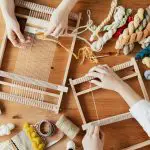When you're looking to choose quality batiste fabric, it's essential to focus on several key factors that can impact your project. You'll want to examine the fiber composition, as natural fibers like cotton or silk provide breathability, while synthetic blends offer durability. Weight and thread count are also critical; a good rule of thumb is to aim for a thread count of at least 80. But how do you ensure the weave quality and overall texture meet your standards? Let's explore these considerations further to help you make an informed choice.
Table of Contents
Understanding Batiste Fabric Types
Batiste fabric typically comes in various types, each offering unique characteristics suited for different projects. When choosing batiste, consider the fiber content, as it can significantly affect the fabric's feel and performance.
Cotton batiste is soft, breathable, and perfect for lightweight garments like blouses and dresses. On the other hand, silk batiste has a luxurious sheen and drapes beautifully, making it ideal for formal wear or delicate lingerie.
Another option is polyester batiste, which provides durability and easy care. This type is often more affordable and resistant to wrinkles, making it a practical choice for everyday wear. If you're interested in a blend, look for cotton-polyester batiste. It combines the softness of cotton with the durability of polyester, offering versatility for various sewing projects.
When selecting batiste, also pay attention to the weave. A tighter weave will give you a smoother finish, while a looser weave may offer more texture.
Evaluating Fabric Weight
When selecting batiste fabric, evaluating its weight is key to ensuring it suits your intended project. Batiste typically ranges from lightweight to medium weight, which can significantly impact how it performs in your sewing projects.
A lighter weight batiste, usually around 1.5 to 3 ounces per yard, is perfect for delicate items like blouses and summer dresses. It drapes beautifully and provides a soft, airy feel. On the other hand, medium-weight batiste, weighing around 3 to 5 ounces per yard, offers a bit more structure. This weight is ideal for items that require more durability, such as children's clothing or linings.
When choosing, consider the type of garment or item you're creating. If you want something flowy and soft, lean toward lighter weights. For garments that need more shape or support, opt for the medium weight.
Don't forget to factor in the fabric's end use. If you'll be layering or adding embellishments, a slightly heavier weight might be necessary to balance everything out. Ultimately, understanding the weight will help you make an informed choice for your sewing needs.
Checking for Thread Count
Checking the thread count of batiste fabric is essential for determining its quality and durability. A higher thread count usually means a softer, more durable fabric, making your projects more enjoyable and long-lasting. When you're shopping, look for a thread count of at least 80 threads per square inch. This density ensures a well-made fabric that can withstand use without fraying or losing its shape.
Here's a helpful breakdown of thread count and its implications:
| Thread Count | Quality Level |
|---|---|
| Below 80 | Low quality |
| 80-100 | Medium quality |
| 100-150 | Good quality |
| 150-200 | High quality |
| Above 200 | Premium quality |
When you're checking the thread count, consider how you'll use the fabric. For delicate garments or items needing more drape, a higher thread count is ideal. If you're making something more functional, like curtains, a lower count might suffice. Ultimately, knowing the thread count helps you make an informed decision and ensures your batiste fabric meets your expectations.
Assessing Fabric Composition
When you're assessing fabric composition, it's crucial to understand the differences between natural and synthetic fibers.
You'll also want to consider how thread count and weave types impact the overall quality of the batiste.
Each of these factors plays a significant role in the fabric's feel and durability.
Natural Vs. Synthetic Fibers
Understanding the differences between natural and synthetic fibers is crucial for making informed choices about batiste fabric.
Natural fibers, like cotton and linen, come from plants or animals. They're breathable, soft, and often more comfortable against the skin, making them ideal for warm weather or sensitive skin. However, they can wrinkle easily and may shrink when washed.
On the other hand, synthetic fibers, such as polyester and nylon, are man-made. They're typically more durable, resistant to wrinkles, and less likely to shrink. This makes them a practical choice for items that need to withstand frequent washing or wear. However, synthetic fabrics mightn't provide the same level of breathability and comfort as natural fibers, and they can trap heat, making them less suitable for hot climates.
When choosing batiste fabric, think about your needs and preferences. If you prioritize comfort and breathability, natural fibers might be the way to go. But if durability and easy care are more important, synthetic fibers could meet your requirements. Ultimately, the right choice depends on how you plan to use the fabric and your personal comfort preferences.
Thread Count Importance
Evaluating thread count is essential for assessing the quality and comfort of batiste fabric. Thread count refers to the number of threads woven into one square inch of fabric. Generally, a higher thread count indicates a denser, softer fabric, which contributes to its overall feel and durability. When you're shopping for batiste, aim for a thread count between 90 and 200 for the best balance of breathability and softness.
Keep in mind that thread count isn't the only factor influencing fabric quality. The type of fibers used and how they're spun also play significant roles. However, a higher count typically means a smoother surface, which can enhance your comfort, especially if you're using the fabric for clothing or bedding.
Don't just focus on numbers; also consider how the fabric feels in your hands. Weave density can affect how light and airy—or heavy and stiff—a fabric feels. So, when evaluating batiste fabric, pay attention to the thread count, but don't overlook the overall texture and drape.
A well-balanced combination of thread count and fiber quality will give you the best batiste experience.
Weave Types Explained
The way batiste fabric is woven significantly affects its texture, durability, and overall quality. When you're assessing batiste, understanding the different weave types can help you make an informed choice.
Here are four common weave types to consider:
- Plain Weave: This is the simplest and most common weave. It creates a flat, smooth surface, making it soft and breathable, perfect for lightweight garments.
- Satin Weave: This weave provides a luxurious sheen and a soft touch, giving batiste a more elegant appearance. It's ideal for special occasion garments but may be less durable.
- Twill Weave: With a diagonal pattern, twill weave adds texture and strength to the fabric. It's more durable than plain weave and can be a good choice for items that require extra wear.
- Jacquard Weave: This intricate weave allows for complex patterns and textures. While it can be heavier, it often offers a unique look that stands out in your wardrobe.
Analyzing Weave Quality
When you examine batiste fabric, pay close attention to its weave quality, as it greatly influences both durability and feel. A high-quality batiste should have a tight, even weave, which contributes to its smooth texture and strength.
Look closely at the fabric; any irregularities or inconsistencies in the weave can indicate poor craftsmanship and may lead to issues later, such as fraying or tearing. You'll want to check for a balanced weave, meaning the threads are evenly spaced both horizontally and vertically. This balance not only enhances the fabric's overall appearance but also ensures it drapes nicely.
If you notice any unevenness or loose threads, it's best to reconsider your choice. Additionally, run your fingers across the fabric. A soft, silky feel typically signifies a well-made batiste. If it feels coarse or scratchy, it mightn't have been woven with the same care.
Lastly, consider the thread count. While batiste is usually lightweight, a higher thread count generally indicates better quality and longevity. By paying attention to these details, you can confidently select batiste fabric that meets your needs.
Testing for Colorfastness
When you're choosing batiste fabric, testing for colorfastness is crucial.
You want to ensure that the colors won't fade or bleed after washing or exposure to sunlight.
We'll explore why colorfastness matters and the best methods for testing it.
Importance of Colorfastness
Ensuring your batiste fabric is colorfast is crucial, as it prevents fading and staining during washing or exposure to sunlight. When you invest in quality fabric, you want it to maintain its vibrant colors over time. Colorfastness guarantees that your batiste won't bleed or run, ensuring your projects remain beautiful and intact.
Here are four reasons why colorfastness is important:
- Longevity: Colorfast fabrics resist fading, meaning your garments and home décor will look fresh for longer.
- Versatility: You can wash, dry, and iron your fabric without worrying about color changes, allowing for greater flexibility in care.
- Quality Assurance: Choosing colorfast batiste reflects your commitment to quality. It shows you care about the final appearance and durability of your projects.
- Cost Efficiency: By preventing color loss and damage, you save money in the long run, as you won't need to replace faded or ruined fabrics.
When you prioritize colorfastness, you're ensuring your batiste projects remain stunning and vibrant, enhancing the overall quality of your creations.
Testing Methods Explained
To determine if your batiste fabric is truly colorfast, you can use several simple testing methods that give you clear results.
One effective method is the damp cloth test. Take a white cloth, dampen it slightly, and rub it against the fabric. If you see color transfer onto the cloth, the fabric isn't colorfast.
Another reliable method is the water test. Wet a small area of the fabric and then press a white cloth against it. If the cloth picks up color, it indicates that the dye may run when exposed to moisture.
You can also try the bleach test for more stubborn dyes. Dilute a small amount of bleach with water, apply it to a hidden area of the fabric, and wait. If the color fades significantly, the fabric isn't colorfast.
Lastly, check the manufacturer's label for care instructions. If they recommend washing in cold water or avoiding bleach, it's a good sign the fabric is treated for colorfastness.
Considering Care Instructions
Understanding the care instructions for batiste fabric helps you maintain its quality and longevity. This delicate fabric requires special attention to keep it looking its best. Here are four essential care tips to follow:
- Washing: Always wash batiste in cold water. Use a gentle cycle to prevent any damage. Avoid bleach, as it can weaken the fibers and cause discoloration.
- Drying: Air drying is the best option for batiste. If you must use a dryer, opt for a low heat setting to minimize shrinkage and prevent fabric distortion.
- Ironing: Use a low heat setting when ironing batiste fabric. It's best to iron it while it's still slightly damp. Always place a pressing cloth between the iron and the fabric to avoid scorching.
- Storage: Store batiste in a cool, dry place away from direct sunlight. Avoid hanging it for long periods, as this can cause stretching. Instead, fold it neatly to maintain its shape.
Frequently Asked Questions
Can Batiste Fabric Be Used for Upholstery Projects?
You can use batiste fabric for light upholstery projects, but it's not ideal for heavy-duty applications. Its delicate nature might wear quickly, so consider it for decorative pillows or lightweight chairs instead.
Is Batiste Suitable for Children's Clothing?
Yes, batiste's lightweight and breathable nature makes it suitable for children's clothing. It's soft against the skin, ensuring comfort. Just ensure you choose a durable blend to withstand active play and frequent washing.
What Are Common Uses for Batiste Fabric?
Batiste fabric's commonly used for lightweight garments, including blouses, dresses, and lingerie. You'll also find it in baby clothes and home textiles like curtains and table linens, thanks to its soft, breathable nature.
How Does Batiste Compare to Other Lightweight Fabrics?
Batiste's lightweight, breathable qualities set it apart from other fabrics like muslin or voile. You'll find it softer and more delicate, ideal for garments, while remaining durable enough for everyday use. It's a versatile choice!
Where Can I Buy High-Quality Batiste Fabric?
You can buy high-quality batiste fabric at specialty fabric stores, online retailers like Etsy or Fabric.com, or local quilting shops. Always check reviews and product descriptions to ensure you're getting the best quality available.
- How Does Ring Spun Cotton Affect Garment Fit and Shape Retention? - August 13, 2024
- What Are the Challenges in Producing Ring Spun Cotton? - August 13, 2024
- Is Ring Spun Cotton Suitable for Plus-Size Clothing? - August 13, 2024







